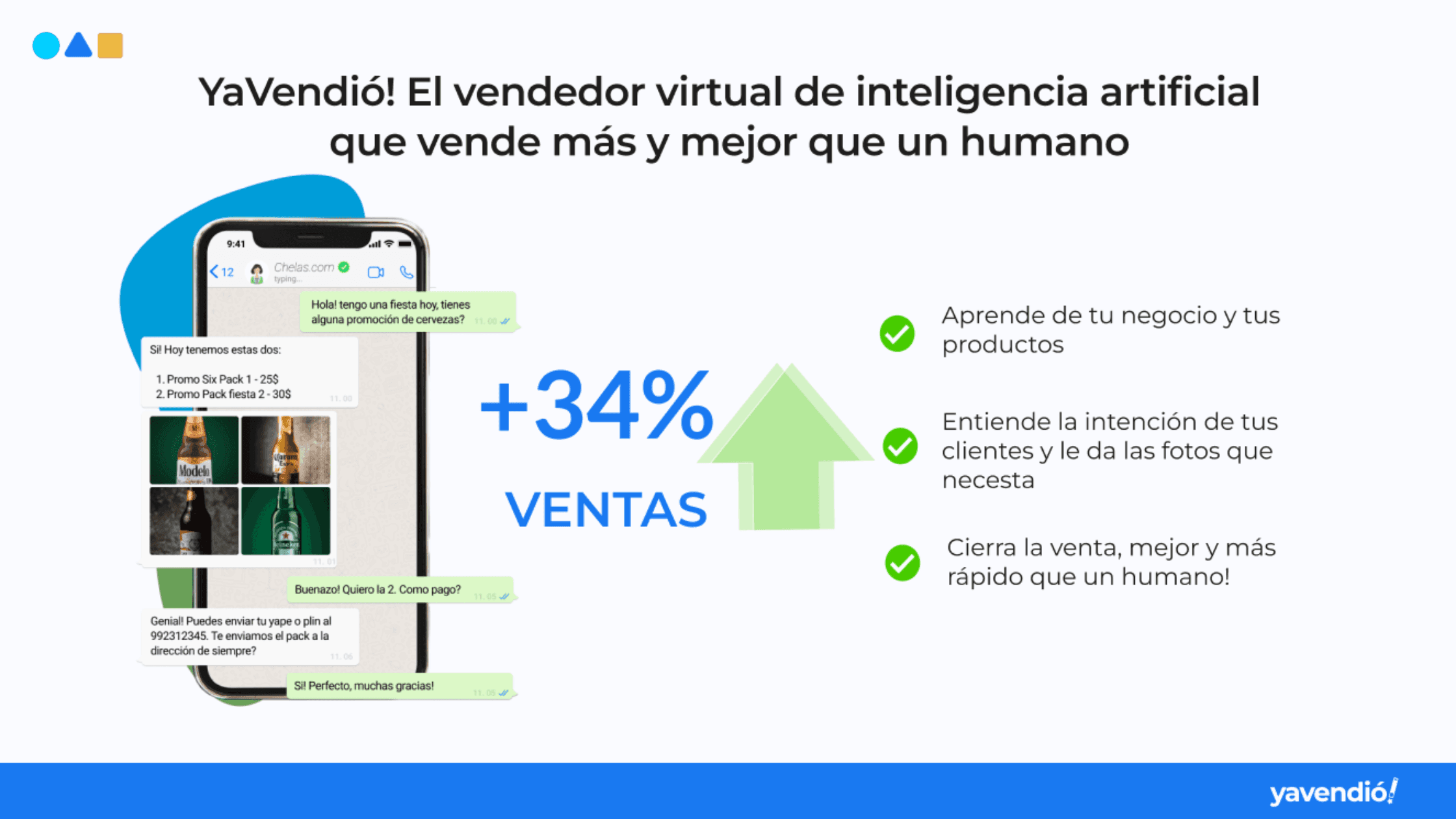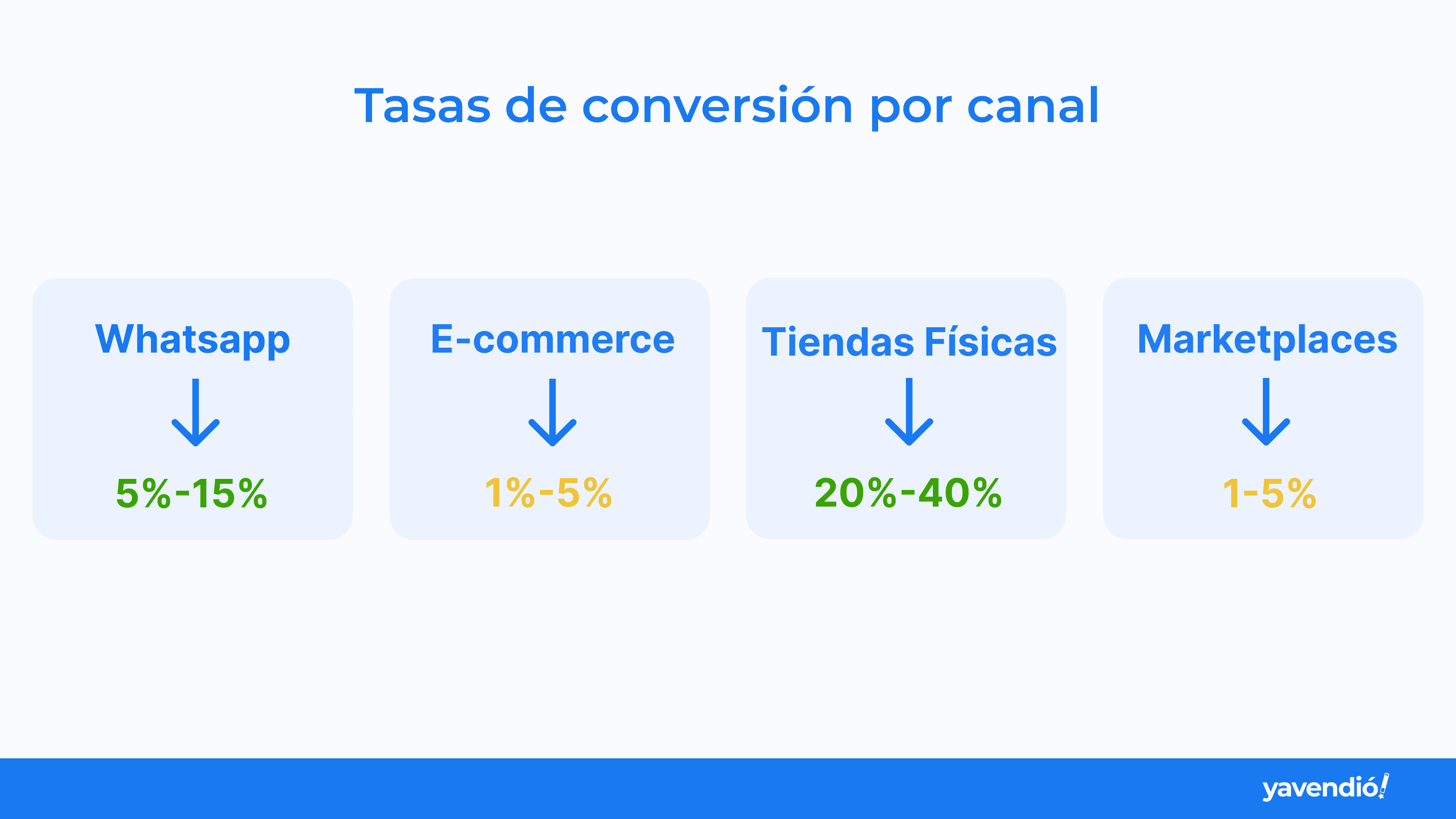Sep 30, 2024
Average conversion rates in ecommerce: Whatsapp, marketplaces, and other channels
Discover the different conversions each channel offers and how you can make the most of each of your leads.
David Tafur
In the world of digital marketing and e-commerce, conversion rates are a crucial indicator of the success of our strategies. These rates vary significantly among the different marketing channels, and understanding these differences can help us optimize our efforts and resources.
In this article, we will examine the average conversion rates for WhatsApp, traditional eCommerce, live broadcasts, physical retail, and other marketplaces.
Before we begin, let's remember:
What is the conversion rate in e-commerce and how is it calculated?
The conversion rate in e-commerce indicates the percentage of visitors who made a purchase on your website or digital channel. You can easily calculate it by dividing the total number of transactions by the number of visits.
This is the conversion rate formula to measure how effective your channels are at converting traffic into sales:

Let's imagine your online store received 5,000 visits this month and generated 125 purchases.
Let's apply the formula:
(125 ÷ 5,000) × 100 = 2.5%
This tells us that your online store has a conversion rate of 2.5%, meaning 2 or 3 out of every 100 visitors made a purchase.
But, is that a high or low conversion rate? Let's see.
What is the average conversion rate in e-commerce?
An online store is no longer the only sales channel available to stand out in e-commerce. Today, there are multiple tools and platforms where customers can interact with your brand and make purchases, each with unique characteristics and behaviors.
In this section, I show you five of these channels and their average conversion rate ranges in e-commerce - note that they can vary depending on the product type, country, or niche. But they will serve you as a starting point to then explore how to optimize your digital sales.
1. WhatsApp Business
WhatsApp has become a powerful tool for direct marketing and sales. Although conversion rates can widely vary depending on the industry and strategy used, average conversion rates have been reported between 5% and 15% for well-executed campaigns on WhatsApp Business.
2. Traditional Ecommerce
Brands' own online stores tend to have lower conversion rates than other channels but offer greater control over the customer experience. Average conversion rates for traditional eCommerce vary between 1% and 4%.
3. Physical Retail Store
Although e-commerce has gained ground, physical stores remain relevant and can offer surprisingly high conversion rates. On average, conversion rates in physical retail range between 20% and 40%.
4. Other Marketplaces
Marketplaces like Amazon, eBay, or MercadoLibre offer access to a wide customer base but also imply greater competition. Conversion rates on these channels typically range between 1% and 5%, depending on the product category and seller's reputation.
5. Live Broadcast
Live shopping has become a trend in e-commerce, captivating consumers with interactive and real-time experiences. This format combines the immediacy of social media with the persuasion of direct marketing, resulting in average conversion rates of up to 10% - well above the average for traditional eCommerce.
Digital Channel | Average Conversion Rate | Characteristics |
|---|---|---|
5% - 15% |
| |
Traditional e-commerce | 1% - 4% |
|
Physical retail store | 20% - 40% |
|
Other marketplaces | 1% - 5% |
|
Live broadcast | Up to 10% |
|
Dinamic Yield shared these average e-commerce conversion rates that can also help you see how you compare at the industry level (calculated from April 2024 to March 2025)
Fashion, accessories, and clothing - 3.28%
Consumer goods - 3.41%
Food and beverages - 5.86%
Beauty and personal care - 4.61%
Multi-brand retail - 4.23%
Luxury and jewelry - 1.19%
Home and furniture - 1.26%
Pet care and veterinary services - 2.97%
How to improve the conversion rate of your online store?
Nobody knows better than you that attracting visitors to your store is not enough: the real challenge is converting those visits into sales. In this section, we will see practical and actionable ideas that you can start applying today to maximize your conversions.
Data-based personalization
People often increase their purchase intention if the experience feels "tailor-made". Start by tracking what your users do: what pages do they visit? What products do they click on? What did they buy before? With that data, create hyper-personalized messages or recommendations.
For example:
If someone viewed sports sneakers, show them a banner that says: "Take advantage of a 10% OFF on these sneakers you loved!".
If they abandoned the cart in your store, send them an email with: "Hi! Do you need help completing your purchase?"
Mobile optimization
Imagine this: a customer tries to buy from their cell phone, but your site takes time to load. You lose a sale before starting! More than half of users abandon a page if it does not load quickly, and this includes your potential customers.
The solution lies in simplifying your purchase process on mobile devices. Fast loading, a 3-step checkout, and responsive design are some ways.
Continuous A/B testing
What happens if you change the "Buy" button from red to green? Or if instead of saying "See offer" you use "Take advantage now!"? A/B tests are like scientific experiments, but for your store, that help you identify the best option to increase your conversion.
For example:
A beauty store changes the text of a call-to-action from "Subscribe" to "Free shipping on your first purchase!" and notices a 30% increase in its conversions.
Emotional loyalty programs
Starbucks does not have a rewards app by chance: retaining a customer is more profitable than acquiring a new one. Create programs that emotionally connect with your customers and motivate them to buy from you:
Digital loyalty cards: "Buy 5 times and the sixth is free".
Exclusive access: "As a VIP customer, we notify you before the launch of new products".
Birthday surprise: A special discount on their birthday.
Automation on WhatsApp and AI agents
Use artificial intelligence (AI) tools to boost your sales through WhatsApp. AI agents can interact with your customers in real-time, resolve questions, and guide them towards making a purchase.

Real Case: MarketZhop Increased Its Ecommerce Store Conversion from 2% to +5% Using WhatsApp as a Sales Channel
MarketZhop, an online store of imported products, faced a common problem in the e-commerce world: despite having a complete website, its sales did not take off.
To make matters worse, every time they launched a social media campaign, they received inquiries via WhatsApp, but these arrived at any hour and not being able to respond instantly, resulted in lost sales.
This had its owner frustrated and worried about not reaching the expected profitability.
How did we help?
At YaVendió!, we know these challenges perfectly. That is why we implemented our virtual seller with artificial intelligence (AI) to manage MarketZhop's catalog.
Thus, customer messages began to be automatically answered through WhatsApp, managing to close sales even on weekends.
The results were impressive
In the first month, MarketZhop went from closing 5 daily orders to more than 20 a day, which meant an increase of +5% in its e-commerce conversion rate, all without investing more in advertising or hiring staff!
➡️ If you also sell through WhatsApp, contact us to learn how we can scale your sales with artificial intelligence.
Conclusion
Each marketing channel has its own strengths and challenges in terms of conversion rates. WhatsApp stands out for its ability to generate high conversions through direct communication, while physical retail maintains its relevance thanks to the immediate experience it offers. Traditional e-commerce and marketplaces, although with lower rates, allow reaching a wider audience.

The key is to develop an omnichannel strategy that takes advantage of the strengths of each platform, continuously optimizing based on data and understanding consumer behavior in each channel.
As the cherry on top, innovative tools like Yavendió's artificial intelligence, a specialized virtual AI seller that responds to messages and closes more sales directly from WhatsApp, are revolutionizing how companies interact with their customers.
By integrating technologies like this, companies can significantly boost their conversion rates, especially in direct channels like WhatsApp, taking the effectiveness of their sales strategies to the next level.
Article updated in April 2025
In the world of digital marketing and e-commerce, conversion rates are a crucial indicator of the success of our strategies. These rates vary significantly among the different marketing channels, and understanding these differences can help us optimize our efforts and resources.
In this article, we will examine the average conversion rates for WhatsApp, traditional eCommerce, live broadcasts, physical retail, and other marketplaces.
Before we begin, let's remember:
What is the conversion rate in e-commerce and how is it calculated?
The conversion rate in e-commerce indicates the percentage of visitors who made a purchase on your website or digital channel. You can easily calculate it by dividing the total number of transactions by the number of visits.
This is the conversion rate formula to measure how effective your channels are at converting traffic into sales:

Let's imagine your online store received 5,000 visits this month and generated 125 purchases.
Let's apply the formula:
(125 ÷ 5,000) × 100 = 2.5%
This tells us that your online store has a conversion rate of 2.5%, meaning 2 or 3 out of every 100 visitors made a purchase.
But, is that a high or low conversion rate? Let's see.
What is the average conversion rate in e-commerce?
An online store is no longer the only sales channel available to stand out in e-commerce. Today, there are multiple tools and platforms where customers can interact with your brand and make purchases, each with unique characteristics and behaviors.
In this section, I show you five of these channels and their average conversion rate ranges in e-commerce - note that they can vary depending on the product type, country, or niche. But they will serve you as a starting point to then explore how to optimize your digital sales.
1. WhatsApp Business
WhatsApp has become a powerful tool for direct marketing and sales. Although conversion rates can widely vary depending on the industry and strategy used, average conversion rates have been reported between 5% and 15% for well-executed campaigns on WhatsApp Business.
2. Traditional Ecommerce
Brands' own online stores tend to have lower conversion rates than other channels but offer greater control over the customer experience. Average conversion rates for traditional eCommerce vary between 1% and 4%.
3. Physical Retail Store
Although e-commerce has gained ground, physical stores remain relevant and can offer surprisingly high conversion rates. On average, conversion rates in physical retail range between 20% and 40%.
4. Other Marketplaces
Marketplaces like Amazon, eBay, or MercadoLibre offer access to a wide customer base but also imply greater competition. Conversion rates on these channels typically range between 1% and 5%, depending on the product category and seller's reputation.
5. Live Broadcast
Live shopping has become a trend in e-commerce, captivating consumers with interactive and real-time experiences. This format combines the immediacy of social media with the persuasion of direct marketing, resulting in average conversion rates of up to 10% - well above the average for traditional eCommerce.
Digital Channel | Average Conversion Rate | Characteristics |
|---|---|---|
5% - 15% |
| |
Traditional e-commerce | 1% - 4% |
|
Physical retail store | 20% - 40% |
|
Other marketplaces | 1% - 5% |
|
Live broadcast | Up to 10% |
|
Dinamic Yield shared these average e-commerce conversion rates that can also help you see how you compare at the industry level (calculated from April 2024 to March 2025)
Fashion, accessories, and clothing - 3.28%
Consumer goods - 3.41%
Food and beverages - 5.86%
Beauty and personal care - 4.61%
Multi-brand retail - 4.23%
Luxury and jewelry - 1.19%
Home and furniture - 1.26%
Pet care and veterinary services - 2.97%
How to improve the conversion rate of your online store?
Nobody knows better than you that attracting visitors to your store is not enough: the real challenge is converting those visits into sales. In this section, we will see practical and actionable ideas that you can start applying today to maximize your conversions.
Data-based personalization
People often increase their purchase intention if the experience feels "tailor-made". Start by tracking what your users do: what pages do they visit? What products do they click on? What did they buy before? With that data, create hyper-personalized messages or recommendations.
For example:
If someone viewed sports sneakers, show them a banner that says: "Take advantage of a 10% OFF on these sneakers you loved!".
If they abandoned the cart in your store, send them an email with: "Hi! Do you need help completing your purchase?"
Mobile optimization
Imagine this: a customer tries to buy from their cell phone, but your site takes time to load. You lose a sale before starting! More than half of users abandon a page if it does not load quickly, and this includes your potential customers.
The solution lies in simplifying your purchase process on mobile devices. Fast loading, a 3-step checkout, and responsive design are some ways.
Continuous A/B testing
What happens if you change the "Buy" button from red to green? Or if instead of saying "See offer" you use "Take advantage now!"? A/B tests are like scientific experiments, but for your store, that help you identify the best option to increase your conversion.
For example:
A beauty store changes the text of a call-to-action from "Subscribe" to "Free shipping on your first purchase!" and notices a 30% increase in its conversions.
Emotional loyalty programs
Starbucks does not have a rewards app by chance: retaining a customer is more profitable than acquiring a new one. Create programs that emotionally connect with your customers and motivate them to buy from you:
Digital loyalty cards: "Buy 5 times and the sixth is free".
Exclusive access: "As a VIP customer, we notify you before the launch of new products".
Birthday surprise: A special discount on their birthday.
Automation on WhatsApp and AI agents
Use artificial intelligence (AI) tools to boost your sales through WhatsApp. AI agents can interact with your customers in real-time, resolve questions, and guide them towards making a purchase.

Real Case: MarketZhop Increased Its Ecommerce Store Conversion from 2% to +5% Using WhatsApp as a Sales Channel
MarketZhop, an online store of imported products, faced a common problem in the e-commerce world: despite having a complete website, its sales did not take off.
To make matters worse, every time they launched a social media campaign, they received inquiries via WhatsApp, but these arrived at any hour and not being able to respond instantly, resulted in lost sales.
This had its owner frustrated and worried about not reaching the expected profitability.
How did we help?
At YaVendió!, we know these challenges perfectly. That is why we implemented our virtual seller with artificial intelligence (AI) to manage MarketZhop's catalog.
Thus, customer messages began to be automatically answered through WhatsApp, managing to close sales even on weekends.
The results were impressive
In the first month, MarketZhop went from closing 5 daily orders to more than 20 a day, which meant an increase of +5% in its e-commerce conversion rate, all without investing more in advertising or hiring staff!
➡️ If you also sell through WhatsApp, contact us to learn how we can scale your sales with artificial intelligence.
Conclusion
Each marketing channel has its own strengths and challenges in terms of conversion rates. WhatsApp stands out for its ability to generate high conversions through direct communication, while physical retail maintains its relevance thanks to the immediate experience it offers. Traditional e-commerce and marketplaces, although with lower rates, allow reaching a wider audience.

The key is to develop an omnichannel strategy that takes advantage of the strengths of each platform, continuously optimizing based on data and understanding consumer behavior in each channel.
As the cherry on top, innovative tools like Yavendió's artificial intelligence, a specialized virtual AI seller that responds to messages and closes more sales directly from WhatsApp, are revolutionizing how companies interact with their customers.
By integrating technologies like this, companies can significantly boost their conversion rates, especially in direct channels like WhatsApp, taking the effectiveness of their sales strategies to the next level.
Article updated in April 2025
Sep 30, 2024
Discover More
YaVendió!: Why do e-commerce businesses choose our AI agent to automate their sales?
YaVendió!: Why do e-commerce businesses choose our AI agent to automate their sales?
YaVendió!: Why do e-commerce businesses choose our AI agent to automate their sales?
Uruguay E-commerce Calendar: 2025 Commercial Dates
Uruguay E-commerce Calendar: 2025 Commercial Dates
Uruguay E-commerce Calendar: 2025 Commercial Dates
Bring the magic to your sales TODAY!
Bring the magic to your sales TODAY!
Bring the magic to your sales TODAY!
@2024 YA VENDIO - All rights reserved
@2024 YA VENDIO - All rights reserved





